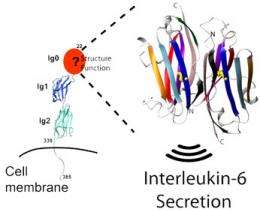Protein involved in disease progression reveals insights for intervention

A team of scientists from the University of Colorado and EMSL has characterized the biology of CD147, a type I transmembrane protein involved in the progression of inflammatory diseases, infections, and cancer—especially the cancer that develops in the cells of the retina, retinoblastoma. Using several methods including EMSL’s high-field nuclear magnetic resonance (NMR), the researchers also identified how the protein’s activity can be disrupted to reveal targets for therapeutic intervention.
The two previously identified isoforms of CD147 (also known as extracellular matrix metalloproteinase inducer or EMMPRIN) that are related to cancer progression differ in their number of immunoglobulin (Ig)-like domains. CD147 Ig1-Ig2 is expressed in most tissues. CD147 Ig0-Ig1-Ig2 is retinal-specific and implicated in retinoblastoma. Until now, little has been known about the retinal-specific CD147 Ig0 domain. The researchers used x-ray crystallography to reveal, for the first time, the three-dimensional structure of the CD147 Ig0 domain and characterized its behavior in solution using several biophysical methods including NMR. They used these data together with mutagenesis to probe the biological activity of CD147 isoforms both with and without the CD147 Ig0 domain within multiple model cell lines.
The team’s findings revealed that the CD147 Ig0 domain is a potent stimulator of interleukin-6, a well-known contributor to retinoblastoma, and suggest that the CD147 Ig0 domain has its own receptor distinct from that of the other CD147 Ig-like domains. The researchers also showed that the CD147 Ig0 dimer is the functional unit required for activity because a single-point mutation that stopped dimer formation resulted in markedly reduced biological activity. These findings provide significant new insights that are critical for understanding the progression of many diseases and their potential intervention.
More information: JS Redzic, GS Armstrong, NG Isern, DNM Jones, JS Kieft, and EZ Eisenmesser. 2011. "The Retinal Specific CD147 Ig0 Domain: From Molecular Structure to Biological Activity." Journal of Molecular Biology 411:68-82.
Provided by Environmental Molecular Sciences Laboratory
















